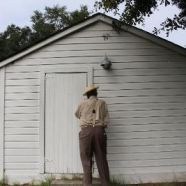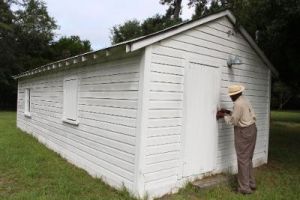
Mr. James Garfield Smalls at the Eddings Point Praise House. Photo by Dr. Elijah Heyward III.
Share This
Print This
Email This
Keeper of the Past: The International African American Museum
Every church along the sea islands has “the person.”
They are keepers of song and tradition with a knack for discerning just the right spiritual, many dating back to the nineteenth century, to enliven worship experiences by igniting an encounter with the divine. They are bridges to our ancestors; men and women who used worship as resistance, as an aspirational tool, as a vehicle of hope. Frogmore or St. Helena Island in Beaufort, South Carolina, is the nexus of barrier islands along the Atlantic coast where community life continues to be shaped by these elders committed to honoring the traditions of the past.
I had the opportunity to interview one such elder during my fieldwork in South Carolina’s Lowcountry. My research focuses on contemporary Gullah Geechee identity. We were told that the culture was dying, but as a native I knew that it was alive because of people like Mr. Garfield. He lived in the community not too far from my great grandmother’s house on St. Helena Island. He was a sought-after worship leader and deacon at St. Joseph Baptist Church who served as a proprietor of praise houses in neighboring Croft and Jenkins. My childhood was enriched by his vibrato. He was the hallmark of any worship experience, particularly Penn Center’s Community Sing, where he set the tone and pace for us as we gathered to connect with our past through tradition. As many praise houses languished, the praise houses under Mr. Garfield’s care remained active by virtue of his stewardship.
The praise houses in Croft and Eddings Point were centers of religious and social life. With origins dating back to the period of African enslavement in America, enslaved people used the one-story gable-roofed structures in the South as meeting places for worship involving prayer, singing, testimony, shouting, and various forms of direct and inherent Christian education.[1] As churches emerged along the islands, the praise houses served an auxiliary function for community worship and preparation for such rites of passage as baptism, which was imbued with great meaning in the Gullah Geechee context.
Mr. Garfield recently died at the age of 100. I will always cherish the time we spent together at the Croft praise house singing, sharing stories, and exploring the significance of the culture—despite the generations between us—that made us who we were.
Mr. Garfield and countless others inspire the work of the International African American Museum where our Gullah Geechee Gallery will feature a replica of a praise house to ensure that the centrality of the people like Mr. Garfield to communities like my own is never forgotten. Our mission is to honor the untold stories of the African American journey at one of our nation’s most sacred sites. We achieve this mission through our museum featuring permanent exhibitions dedicated to the complicated nuance of the African American journey beginning in west and central Africa with a significant touch point in Charleston, South Carolina. Charleston was the single greatest point of entry for African captives in America. We honor this significant fact through our collections, an Ancestors Memorial Garden, which will be a place for reflection and remembrance conceived by Macarthur Genius award recipient Walter Hood; and what we hope will be a preeminent genealogy center, our Center for Family History. Our museum will be a point of pilgrimage for all Americans, but particularly African Americans who can trace their familial lineage to Charleston and the site of the museum.
Mr. Garfield took his role as proprietor very seriously, as my colleagues and I do as proprietors of a history filled with far too many untold stories that continue to shape not only the South, but our nation and the world. His one hope was that future generations sustain an appreciation for the traditions that shaped his life and community. So much of the Southern mystic is defined by memory and memorialization. What is remembered and memorialized continues to reflect our societal values and norms in complicated ways. It is my hope that as a scholar of the American South with a particular investment in the African American experience that our museum in Charleston, South Carolina—a city that not only heralded the start of the Civil War but a city where Black men and women harnessed their agency through multifaceted resistance—can, with our institution as a resource, create a new approach to reconciliation.
[1] National Register Properties in South Carolina, Eddings Point Community Praise House, Beaufort County (S.C. Sec. Rd. 183, St. Helena Island)







